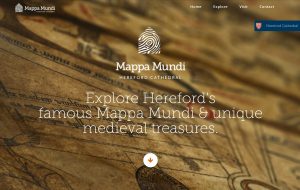I chose to reverse engineer the project title, “Mappa Mundi.” This project focuses on Hereford Cathedral and their possession of the Mappa Mundi, an ancient calf skin map from 1300 which lays out the world from an ancient European Christian perspective. The Hereford Cathedral “Mappa Mundi” project also boasts about their Chained Library and extensive collection of medieval books.
When you click on the image below, it will take you to the website for the project.
To reverse engineer this project, I needed to break it down and dissect the key components. I have identified the sources, processing, and presentation aspects of the project.
I began with looking at the sources used in the “Mappa Mundi” project. I searched around the website to find out what types of raw materials the developers used. The first item I noticed was the use of the Hereford Mappa Mundi artifact. The map was used in various ways around the website, and is a main source of information for this project. I also saw the project used the Great Charter of Liberties (Magna Carta) artifact. There was a separate section for information pulled from this source. Photos of the Hereford Cathedral Chained Library and Medieval Library were used extensively throughout the website. Additionally, book titles, book descriptions, photos of paintings from books, and photos of books in the Hereford Cathedral Chained Library and Medieval Library were used as sources to put this project together. Illustrations and photos of the Hereford Cathedral were also used. The last source I found was a Google map displaying the location of the Hereford Cathedral.
The “Mappa Mundi” project performed a bit of processing in order to translate the physical sources they used into something which can now be viewed on a computer. To process this information, they created a summary and narrative of the information. All of the information was also categorized and organized to make it palatable to the general public. Artifacts and book texts were all digitized, which was essential for putting this project together. Photographing was performed, and photographs were enhanced and edited.
In order for us to view the “Mappa Mundi” project as it is now, the developers needed to use presentation methods. The information for this project has all been made web-accessible. The Mappa Mundi artifact has been made interactive, creating an engaging and captivating way for viewers to become educated on this subject matter. There is also an interactive 3D image of the Mappa Mundi artifact, which further enhances the project for our viewing.
From dissecting the “Mappa Mundi” website and discovering the sources, processing, and presentation elements, I have been able to reverse engineer the project.

Hi, I really enjoyed the explanation in your reverse engineer about “Mappa Mundi,” it was very creative for you to link the website in your picture. It was very easy to follow the steps in your blog as you explain it in your own perspective (the usage of “I began…). I particularly enjoy the strange people category of this digital humanities site, I thought it was very interested how the creator is able to connect geography map with history behind it. I also really enjoy the 3D scan as well, the digitalized photo and description allows us the view the process behind this project more in-depth.
Hello,
Since I am very new to all this digital humanities material, I think you did a great job of explaining each component. It allows me to dissect each part of the website and see how it was arranged. The detail you go into also allows me to see how it was set up and how they made this website. I didn’t look over this one, but the way you described it, it seems very interesting and like a successful scholarly website.
Hi there,
I really like the way you have reverse-engineered this project, it was an easy read with you outlining each stage throughout the process. I particularly thought it was cool that you linked the photo to the website!! I must admit when I first checked out this website, as a rookie at digital humanities, I felt a little overwhelmed. However, once I read your blog I went back through and noticed the seperate components you mentioned such as the additional photos and the google map that was displaying the Hereford Cathedral. The “Mappa Mundi” was a tough website and you reverse-engineered it very well.